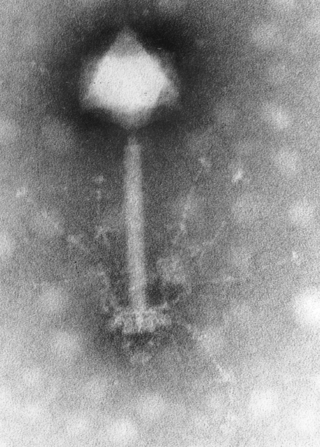
A bacteriophage, also known informally as a phage, is a virus that infects and replicates within bacteria and archaea. The term was derived from "bacteria" and the Greek φαγεῖν, meaning "to devour". Bacteriophages are composed of proteins that encapsulate a DNA or RNA genome, and may have structures that are either simple or elaborate. Their genomes may encode as few as four genes and as many as hundreds of genes. Phages replicate within the bacterium following the injection of their genome into its cytoplasm.

Enterobacteria phage T2 is a virus that infects and kills E. coli. It is in the genus Tequatrovirus, and the family Myoviridae. Its genome consists of linear double-stranded DNA, with repeats at either end. The phage is covered by a protective protein coat.

Escherichia virus T4 is a species of bacteriophages that infect Escherichia coli bacteria. It is a double-stranded DNA virus in the subfamily Tevenvirinae of the family Straboviridae. T4 is capable of undergoing only a lytic life cycle and not the lysogenic life cycle. The species was formerly named T-even bacteriophage, a name which also encompasses, among other strains, Enterobacteria phage T2, Enterobacteria phage T4 and Enterobacteria phage T6.

Myoviridae was a family of bacteriophages in the order Caudovirales. The family Myoviridae and order Caudovirales have now been abolished, with the term myovirus now used to refer to the morphology of viruses in this former family. Bacteria and archaea serve as natural hosts. There were 625 species in this family, assigned to eight subfamilies and 217 genera.

Filamentous bacteriophages are a family of viruses (Inoviridae) that infect bacteria, or bacteriophages. They are named for their filamentous shape, a worm-like chain, about 6 nm in diameter and about 1000-2000 nm long. This distinctive shape reflects their method of replication: the coat of the virion comprises five types of viral protein, which are located in the inner membrane of the host bacterium during phage assembly, and these proteins are added to the nascent virion's DNA as it is extruded through the membrane. The simplicity of filamentous phages makes them an appealing model organism for research in molecular biology, and they have also shown promise as tools in nanotechnology and immunology.
A viral structural protein is a viral protein that is a structural component of the mature virus.

Escherichia virus T5, sometimes called Bacteriophage T5 is a caudal virus within the family Demerecviridae. This bacteriophage specifically infects E. coli bacterial cells and follows a lytic life cycle.
Experimental evolution studies are a means of testing evolutionary theory under carefully designed, reproducible experiments. Given enough time, space, and money, any organism could be used for experimental evolution studies. However, those with rapid generation times, high mutation rates, large population sizes, and small sizes increase the feasibility of experimental studies in a laboratory context. For these reasons, bacteriophages are especially favored by experimental evolutionary biologists. Bacteriophages, and microbial organisms, can be frozen in stasis, facilitating comparison of evolved strains to ancestors. Additionally, microbes are especially labile from a molecular biologic perspective. Many molecular tools have been developed to manipulate the genetic material of microbial organisms, and because of their small genome sizes, sequencing the full genomes of evolved strains is trivial. Therefore, comparisons can be made for the exact molecular changes in evolved strains during adaptation to novel conditions.
DNA-dependent ATPase, abbreviated Dda and also known as Dda helicase and Dda DNA helicase, is the 439-amino acid 49,897-atomic mass unit protein coded by the Dda gene of the bacteriophage T4 phage, a virus that infects enterobacteria.
Enquatrovirus is a genus of bacteriophages in the order Caudovirales, in the family Podoviridae. Bacteria serve as natural hosts. There is currently only one species in this genus: the type species Escherichia virus N4.
Enterobacteria phage P4 is a temperate bacteriophage strain of species Escherichia virus P2 within genus Peduovirus, subfamily Peduovirinae, family Myoviridae. It is a satellite virus, requiring P2-related helper phage to grow lytically.
Escherichia virus 186 is a virus of the family Myoviridae, genus Eganvirus.
Pseudomonas virus 42, formerly Pseudomonas phage 42, is a bacteriophage known to infect Pseudomonas bacteria.

Kuttervirus is a genus of bacteriophages in the family Ackermannviridae. The genus contains 40 species.
Tequatrovirus is a genus of viruses in subfamily Tevenvirinae of family Straboviridae. Gram-negative bacteria serve as the natural host, with transmission achieved through passive diffusion. There are 84 species in this genus.
Zindervirus is a genus of viruses in the family Autographiviridae, within the subfamily Molineuxvirinae. Bacteria serve as the natural host, with transmission achieved through passive diffusion. There are currently three species in this genus, including the type species Salmonella virus SP6.

Teseptimavirus is a genus of viruses in the order Caudovirales, in the family Autographiviridae, in the subfamily Studiervirinae. Bacteria serve as the natural host, with transmission achieved through passive diffusion. There are currently 17 species in this genus, including the type species Escherichia virus T7.
Lambdavirus is a genus of viruses in the order Caudovirales, in the family Siphoviridae. Bacteria serve as natural hosts, with transmission achieved through passive diffusion. There are five species in this genus. The genus also includes several unclassified viruses—including the corynephages β and ω, which infect Corynebacterium diphtheriae and carry the deadly diphtheria toxin.
Tequintavirus is a genus of viruses in the order Caudovirales, in the family Demerecviridae. Bacteria serve as the natural host, with transmission achieved through passive diffusion. There are currently 22 species in this genus, including the type species Escherichia virus T5.
Escherichia virus CC31, formerly known as Enterobacter virus CC31, is a dsDNA bacteriophage of the subfamily Tevenvirinae responsible for infecting the bacteria family of Enterobacteriaceae. It is one of two discovered viruses of the genus Karamvirus, diverging away from the previously discovered T4virus, as a clonal complex (CC). CC31 was first isolated from Escherichia coli B strain S/6/4 and is primarily associated with Escherichia, even though is named after Enterobacter.







